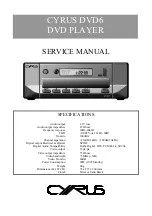
Appendices : MPEG Settings (MainConcept Encoder)
Page 252
Noise Reduction
is a specific noise filter. It reduces the noise in a frame (spatial reduction), but it doesn’t do it
from frame to frame (temporal reduction). The value range is
0
...
31
. It increases the video quality but also the
encoding duration.
Motion Search Mode:
Motion search mode
Defines which method is used to search for pixel movement in the video stream. A higher
value specifies a better method and will normally yield better quality. The practical range
is 3 to 11. It increases the video quality but also the encoding duration.
Do half-pel Search
When this option is activated the Motion Search operation also looks for pixels that move
only 1/2 of a pixel from one frame to the next (a subpixel search). This should usually be
enabled and should only be disabled if speed is desired above quality.
Set motion search areas from pixel movement: These settings specify the maximum movement of a pixel from one frame to the
next.
They are used to calculate the Motion Search Areas, the maximum area the encoder will search in an attempt to
find a match for a block of pixels from one frame to the next. If the video has quite a bit of movement, it is useful to
raise these values. Unfortunately, this also extends the encoding time.
These settings are an easy way to manipulate the Motion Search vectors. The motion search vectors can also be
manually manipulated in the Motion Estimation section of the Additional Settings tree. The motion search vectors
are different and optimized for the different frames and frame types.
Start Time (seconds):
This option specifies the starting TimeCode in the GOP header of the video stream.
It is independent of the TimeCodes in the program stream. This TimeCode is specified as a frame number which is
converted to a hr:min:sec:frames type TimeCode and placed in all GOP headers (automatically incremented). For
instance, with 25 fps and a Start Time set to 300, the first TimeCode would be 00:00:12:00 or 12 seconds As another
example, one could encode 1 hour of video with the start time set to zero, then encode another hour of video with
the start time set to 3600 seconds. Then when the two videos are played one after the other the TimeCode will be
continuous between the two files.
Input video is RGB 16-235
When checked, particular black and white values are preserved.
During encoding and decoding the RGB color space with R=G=B=16 is used, which corresponds to the color black.
Furthermore, the RGB color space with R=G=B=235 is used, which corresponds to the color white. Normally the
values for white are R=G=B=0, and for black R=G=B=255. The specification ITU601R now defines black (Y=16) and
white (Y=235), i.e. the real video signal receives values which are “blacker than black“or “whiter than white“(so
called super-black and super-white values). These super-black and super-white values get lost in the normal PC
RGB 0..255 color space, but they are preserved with the
Input video is RGB 16-235
option.
User Quant(ization) Matrices
When checked a user defined quantization matrix is used.
The matrix can be edited by clicking on the Edit button.
Each 8x8 block of pixels in the image is run through a DCT (Discrete Cosine Transformation) function which yields
an 8x8 block of DCT coefficients. These coefficients are arranged in the 8x8 array with the lower frequencies in the
upper left corner of the array and the higher frequencies in the lower right corner. The numbers of these 8x8
blocks are the results of mathematical functions performed by the encoder to represent the video in a smaller
number of bits.
The quantization matrices determine the divider used by the quantization function for each DCT coefficient.
Lower numbers mean the coefficient will be quantized less (better quality, closer to the original DCT value but
more bits are needed), while higher numbers mean the coefficients are quantized more (lower quality but less bits
are needed). The default intra matrix values are biased towards the low frequency coefficients; they are repre-
sented better while the high frequency coefficients are not represented as well. The numbers on the top left han-
dle the low frequency regions, and the numbers on the bottom right handle the high frequency regions. The
human eye is less sensitive to the high frequencies, so that region can be compressed to a higher degree; this is
why the values are higher there. If the whole matrix consists of 1, there would be virtually no compression at all
Содержание VCube
Страница 1: ...USER MANUAL User Manual...
Страница 9: ...Page 9 Document revision 22 Date 28th November 2012...
Страница 13: ...Introduction VCube Keys Options Page 13 VCube Versions...
Страница 196: ...Output View Output Page Diagnostic Tools Page 196 Audio Meters Shows audio Playback levels Output Page Audio Meters...
Страница 231: ...Appendices HDTV Recorded Media Page 231 HDTV Recorded Media SDTV Recorded Media...
Страница 264: ...Appendices Pro Tools VCube Operation Page 264 Pro Tools VCube Operation...
Страница 270: ...Appendices Pro Tools and VCube Page 270...
Страница 273: ...Appendices Pro Tools and VCube Page 273...
Страница 274: ...Appendices Pro Tools and VCube Page 274...
Страница 275: ...Appendices Sony 9 Pin RS422 Wiring Chart Page 275 Sony 9 Pin RS422 Wiring Chart...
Страница 276: ...Appendices Sony 9 Pin RS422 Wiring Chart Page 276...
Страница 277: ...Appendices Sony 9 Pin RS422 Wiring Chart Page 277...
Страница 278: ...Appendices Sony 9 Pin RS422 Wiring Chart Page 278...
















































